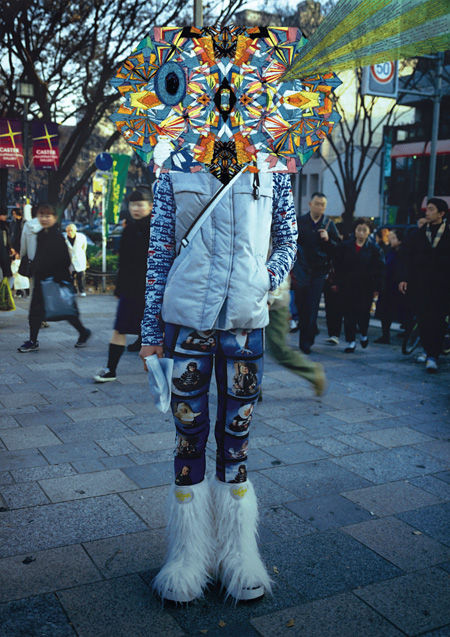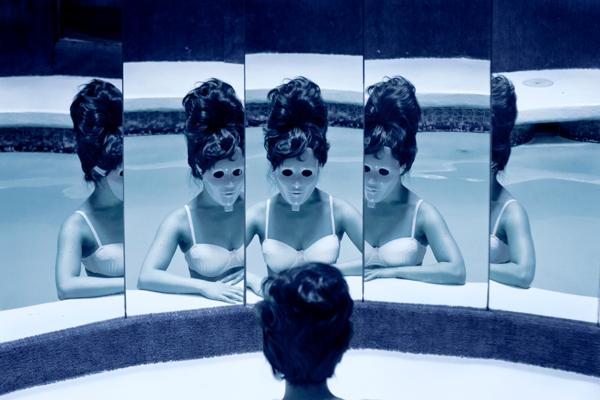
Tokyo Rumando, Untitled, from the series Peel Apart, 2015-16
Tokyo Rumando: This work is a part of my challenging process to create abstract self-portraits. As someone who makes self-portraits, this is indeed a very difficult subject as it is difficult to “erase” ourselves. When expressions and contours become unclear, anonymity is born and the concept of (my)self is removed from the viewer’s perception. I think I will disappear and become an abstract object when I am excluded from recognition. The meaning of this disappearance is nothing negative and I believe it is part of the process of creating something new.
IBASHO Gallery: Tokyo Rumando’s work reveals an intuitive drive for authenticity defying gender roles that the Japanese patriarchal society has put on its women. Comparable to her Western predecessors such as Claude Cahun, Cindy Sherman and Gillian Wearing, Tokyo Rumando refigures the traditional female identity by performing the self explicitly as a masquerade.

Asami Kiyokawa, Wanna erase everything in the world, from the series Tokyo Monster, 2014
Asami Kiyokawa: It is a great mystery why people have dressed in a certain way to express themselves throughout different points in history. Of course, the 1990s in Tokyo was no exception. Using fashion snapshots taken in central Tokyo for Japanese fashion magazines in the 90s as a motif, I have exposed those young people and their complex feelings of anxiety and vanity as “monsters”.
Sawako Fukai (Director, G/P Gallery): It is interesting to find the exact same identity crisis among young people in this post-internet SNS age and those, for example, in the 60s. The youth now seems to have gained more freedom and accessibility to expose themselves, but some elements in life never get sped up. However, it is also a fact that darkness is more disguised nowadays behind superficial posts on smartphones. Asami Kiyokawa finds those complex and delicate feelings among the faces in the snapshots taken in the 90s and carefully lifts them up to the surface with sincere disguise with her embroidery, which highlights the universal figures of young people, going beyond the border of gender or race.

Juno Calypso, Silent Retreat, from the series The Honeymoon Suite, 2016
Hannah Watson (Director, TJ Boulting): There is a certain ambiguity in Juno’s work as it’s not immediately obvious that the work is a self-portrait. It’s interesting to challenge people’s preconceptions that the image is taken by a man of a woman. Revealing the work as a self-portrait subverts connotations from the male gaze and voyeurism into empowerment and control of the female artist.

Momo Okabe, Untitled, from the series Tote, 2015
Momo Okabe: Whenever I turn the camera towards him or her I see myself. Behind the camera exists me, whose soul has fallen out. After a night of experimentation, follows a morning of discovery. I start walking in the world full of surprise with everyone that I meet.
“I start walking in the world full of surprise with everyone that I meet.”

Camille Vivier, Sans titre, 2016
Kirsten Hermann (Founder, Galerie für Moderne Fotografie): When leafing through the portfolio of French photographer Camille Vivier it is easy to be tempted to do what so many often do: compare her art to that of famous men. To David Lynch, for example, and his pop-esque, morbid atmospheres. To Guy Bourdin and his overly artificial presentations of women. To Man Ray and his deliberate confusion of animate and inanimate bodies. Or even to Michelangelo Antonioni and his hard-edged details, or the melancholic slowness of his camera movements. And in rare cases you also think of Helmut Newton. The tendency is to ascribe all kinds of male influences to her work. But this is exactly what Camille Vivier is not: a man who looks at women. Vivier is a young woman who looks at other young women.
Camille Vivier: My work is indeed, feminine, as I am a woman photographing other women, but I am not fixed with genders, I am looking for more abstraction. It is feminine in a more suggestive way, related to nature and our perception of things, even in the inanimate, drawing analogies between shapes and between different genders.
I also like the evocative power and poetry of words and images, I am french and have been used (since I was a child) to giving a gender to every word. I guess my first empowerment over things was to recreate my vocabulary, by creating correspondences or by blurring the boundaries between the feminine and the masculine.

Miles Aldridge, (after Cattelan) #4, from the series (after Cattelan), 2016
Miles Aldridge: In my work, the women are always the heroes. Sometimes they are like the muses of the Renaissance, inspiring and beautiful but they can also be like The Furies of ancient Greek art, wreaking vengeance and humiliation on men, whether they are Maurizio Cattelan or The Pope.
Alex Daniëls (Galerie Alex Daniels- Reflex Amsterdam): In the collaborative project (after Cattelan) Miles Aldridge’s powerful, stunning women and unique use of colour go into dialogue with the works, commenting on male dominance, religion, politics and sex, the subject matters Maurizio Cattelan visualizes brilliantly. The junction of their work creates a new interesting tension and simultaneously explores the effects of combining two mediums, photography and sculpture. It shows a fresh angle on the work of both artists.
Unseen Amsterdam runs from 22 to 24 September. unseenamsterdam.com




